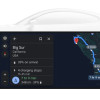How To Take a Screenshot on Android
May 23, 2024, 8:59 PM by Rich Brome @rbrome.bsky.social

Do you need to take a screenshot on your phone? There's no obvious, on-screen button for that, because that would defeat the purpose. You need to know the "trick". Read on for straightforward, illustrated instructions for any Android phone. We won't waste your time.
These instructions are for Android phones, like a Samsung Galaxy, Google Pixel, Motorola, or basically any non-Apple smartphone. If you have an Apple iPhone (iOS), we also have an article for how to take a screenshot on iPhone.
How
The short answer is: press the power and volume-down buttons at the same time to take a screen-shot.
taking a screenshot

The power button (AKA the "lock" or "side" button) is usually a shorter button immediately next to the volume control. It may be above or below it; this varies. However, on some phones, it may be on the opposite side from the volume control. The power button is almost always on the top half of the phone, if your phone also has other buttons elsewhere on the sides. On some phones, the power button doubles as a fingerprint reader.
The volume control is usually the longest/skinniest button on the side (on the right is common, but some are on the left.) Pressing the top half is "volume up" and the bottom half is "volume down". It may also be two separate, matching buttons next to each other.
If you're not sure which buttons are which, check your phone's user manual. Close to the beginning should be a diagram with all of the buttons labeled.
Then what?
After the screen shot is taken — usually confirmed by the screen briefly flashing white and a short animation — you will usually have a little pop-up in the lower-left corner (or across the bottom) for several seconds, with a thumbnail of the screenshot and one or more shortcut action buttons. You can tap the screenshot thumbnail image to open it in your phone's photo viewer, where you can edit, save, share, delete, or do whatever you want with the image. You may also see little button with a pencil icon that does the same thing.
screenshot taken

Another button in the little pop-up is "share", denoted by the standard "share" icon of three dots connected by lines in a "c" shape. (Or it might simply say "Share".) Tapping that will give you options for sharing the image via text message, social networks, email, etc.
If see a "Capture more" or "Scroll" button, we'll go over that in the "More options" section below.
If you hesitate and miss the temporary pop-up, you can find the screenshot in your phone's photos app. Screenshots may not be saved in the same place as your camera photos. For example, in Google Photos, you'll need to go to the "Library" tab than "Screenshots". You'll also find edit and share options there.
You may also find a Google Lens option in the pop-up and/or when you open the screenshot in your photos app. Google Lens will let you use all or part of your screenshot to perform an image search. This gives you all kinds of AI-powered options, like language translation, finding a specific product, animal, or plant by its photo, and much more.
More options
If you're taking a screen-shot of a web browser, social media, or other app with content that scrolls up and down, you should get another option right after you take a screenshot: "Capture more" or "Scroll". This is for what's known as a "scrolling screenshot". Tap this button and you get a special interface that looks like a photo cropper, but works in reverse: it lets you expand your screenshot to include content that you'd otherwise have to scroll to see.
scrolling screenshot

On some Motorola phones this works a little differently. The scrolling screenshot button is a small icon overlapping the bottom of the thumbnail in the pop-up, with an arrow pointing down. When you tap it, it does a little animation showing the scrolling and then saves the expanded screenshot.
Note that scrolling screenshots were introduced with Android 12, so phones running an earlier version of Android may not have that feature. Also, this feature is compatible with most apps that have scrolling content, but not all.
Most Android phones also have an additional option: screen recording. This is like a screen-shot, but video. Unlike a screen-shot, you'll need to access this from Quick Settings. Swipe down from the top of the screen (like you would to view notifications). Then swipe down again to reveal all Quick Settings buttons. If you don't see "Screen record", swipe left to reveal more options off to the right. (If still don't see "Screen record", you may need to tap the little button with the pencil icon to edit your Quick Settings to include "Screen record".)
You can stop recording by swiping down from the top of the screen and tapping "Stop" in the screen recording notification.
Not working?
Do these instructions not work for you? They should work for most Android phones, but one of the unique things about Android is that manufacturers are free to customize the software in many ways, so it is possible that your phone is different. In which case check your phone's user manual.
Comments
No messages


 How To Take a Screenshot on an iPhone
How To Take a Screenshot on an iPhone
 How To Scan a QR Code with Your iPhone
How To Scan a QR Code with Your iPhone
 How To Scan a QR Code with Your Android Phone
How To Scan a QR Code with Your Android Phone
 Android Auto Will Know Your EV's Battery Level
Android Auto Will Know Your EV's Battery Level








